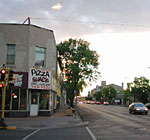By Brandt Williams
Minnesota Public Radio
September 25, 2002
The tensions between Minneapolis police and the city's minority residents have eased little in the 10 years since Jerry Haaf was killed. Just weeks ago the tension erupted into a riot in the Jordon neighborhood after police accidentally shot a young boy during a drug raid. Reporters were assaulted and news vehicles were burned. For residents, the scene was a familiar one.
| |
|
|
|
||
A North Minneapolis church holds an outdoor service on a cool, blue breezy last day of summer. The 25 congregants sit on metal folding chairs in the church parking lot, some shivering from the nippy weather. The wind reminds them, they are at the mercy of the environment.
"I guess it's going to be a little windy, as you can tell," says Pastor La Andrimaja, as he tries to keep his sermon from blowing away.
The wind is just one harsh reality facing members of the Jordan New Life church. During the service, two open-air drug deals are conducted within sight of the church-goers. Later, a police cruiser drives slowly by. Officers closely watch a young black man in a bright red sweatsuit walk by.
For churchgoer and neighborhood resident Linda Robinson both sights are common. Robinson says she's tired of the crime and drug dealing in the neighborhood. But she says some police officers treat law-abiding black residents and law-breaking black residents the same way.
"They could have just dealt with someone on 26th and come to my house to see a possible robbery and they're dealing with me the same way they dealt with the person who selling drugs," she says. "So it depends on where they are. I guess they need to go back to humanity classes."
Both Robinson and the church are located just blocks from the epicenter of the disturbance in August, when police accidentally shot a young boy during a drug raid. She's lived in Minneapolis for more than 20 years and remembers the shooting of officer Jerry Haaf. Robinson says relations between police community they are supposed to protect have declined since then.
Activists like Spike Moss describe the situation more bluntly. "We're still dealing with the same situation of race hate -- not racism -- race hate perpetrated on our people behind the badge," says Moss. "And that's a dangerous situation when you abuse the law, abuse the badge and the oath that you take to abuse people of color."
Moss is the vice president of the The City, Inc. In 1992, he helped organize United For Peace, the group of gang members who worked with Minneapolis police to quell gang violence. Ten years later, Minneapolis police brought in The City, Inc. to keep the peace in Jordan.
Moss and other activists point to statistics that show the ratio of blacks sent to Minnesota prisons compared to whites is the highest in the country. Traffic stop data collected by both Minneapolis and St. Paul police departments show that African American motorists were more likely than whites to be pulled over.
Jim Nelson was the director of The City, Inc., 10 years ago when officer Haaf was shot. Nelson knew the young men convicted of the Haaf killing. He says the race and residency of police officers are still factors which instill distrust of the police among the city's minority residents.
"From my perspective, having worked in south Minneapolis since 1971, it's easy to see how you would call the police force an army of occupation," he says.
Nelson says the predominantly white police force is made up of people who don't live in the city can't or won't distinguish between law-abiding African Americans and those who are criminals.
"You don't live here, you work here," says Nelson. "You don't look like us, you don't know us. That's a huge problem."
Over the past decade, the crackdown on gang activity has led to a decline in violent crime. But Nelson, who wrote his doctoral thesis on his 14 years at The City Inc., says crime fighting is only one strategy. And so far, no one is taking on the harder job of trying to keep young people from entering a life of crime.
"Folks, we've learned these lessons. We've learned these lessons," he says. "If you're not going to directly engage the young people who are causing problems to find out what's up with them and then figure out how you can develop opportunities for them to get involved in other things, you're going to reap what you sow."
Nelson and other activists say until those larger community problems are tackled, there is always a chance for unrest, like that in Jordan last month and that which claimed the life of Jerry Haaf 10 years ago.
More from MPR
